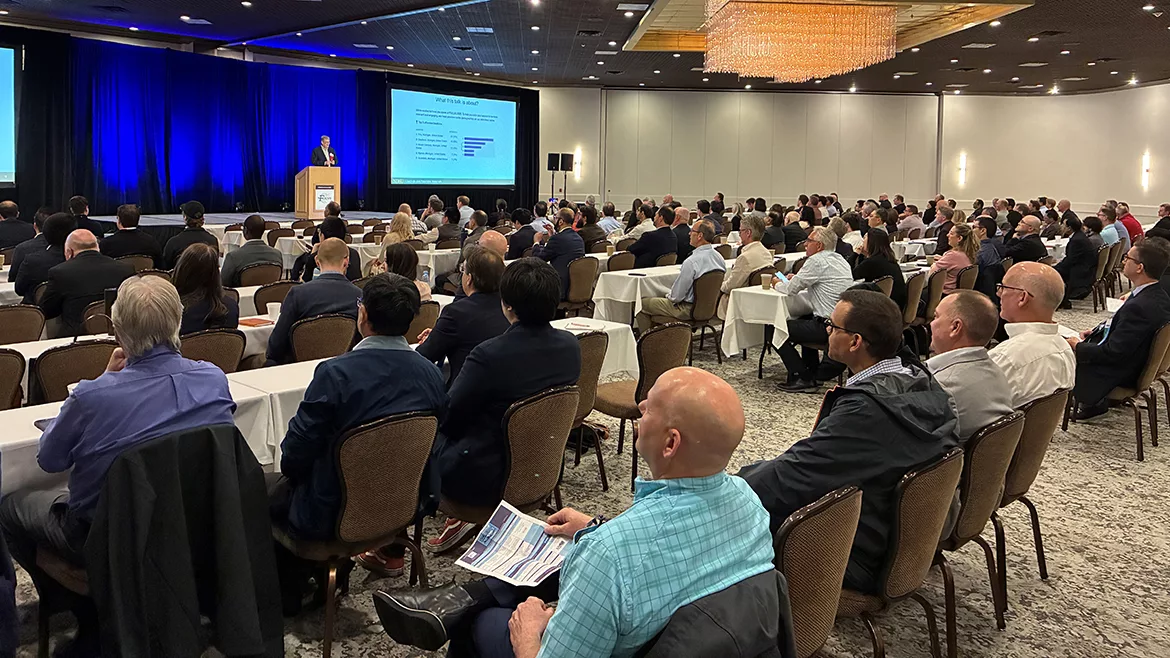Consider Collaborating

FOCUS conference keynote. Image courtesy of Kristin Johansson.
May was a whirlwind of coatings shows and conferences, including Coatings Tech, FOCUS, the SSCT Annual Conference, the Eastern Coatings Show, RadTech and the Canadian Coatings Conference. They were all great events and covered a variety of trends and technologies our industry encounters today.
The keynote presentation at the Detroit Society for Coatings Technology’s FOCUS Conference was particularly interesting to me. Dean Webster, Professor and Chair at North Dakota State University, spoke on how collaborations can fuel innovations. He noted that organizations can attempt to solve problems that are impacting the coatings industry on their own or they can expand their scope of expertise through collaborations with other organizations and their researchers. Collaborations can have many benefits including broadening perspective, accessing expertise and leveraging resources. The ultimate objective with collaborations is to accelerate development and arrive at new innovations.
The main focus of his presentation was university/industry collaboration. Universities offer forward-thinking and creative faculty, new ideas and concepts, expertise your company may not have, advanced analytical capabilities, and the opportunity to develop relationships with future employees.
Webster provided a number of ways that industry can collaborate with universities, including:
- Joint projects with external funding;
- Direct funding of projects; and
- Membership in a consortium.
Protecting intellectual property is a concern when considering collaborating – especially if the research is federally funded. In other words, who owns the IP – the government, the university or the company? Webster explained that agreements between companies and universities are developed, and that most universities have crafted more “industry-friendly” IP policies. According to the World Intellectual Property Organization, these policies address key issues such as ownership of IP and rights of use, IP disclosure, IP management, commercialization of IP, incentives for researchers and technology transfer professionals, recording and accounting, and conflicts of interest. These policies provide legal certainty, promote scientific research and technological development, and balance the various conflicting interests of universities and industry. Additionally, Webster explained that the Bayh-Dole Act of 1980 (or Patent and Trademark Law Amendments Act) offers further protection. It permits ownership by contractors of inventions arising from federal government-funded research.
Finally, Webster touted the benefits of joining a consortium. Consortium members contribute financially to the research, and the funds are pooled and then used to fund specific projects. Members usually have input into these projects and have access to project results. Webster’s own university is part of The Center for Bioplastics and Biocomposites (CB2), a National Science Foundation Industry & University Cooperative Research Center (I/UCRC) that focuses on developing high-value biobased products from agricultural and forestry feedstocks. The vision of the center is to develop the knowledge that will allow the production of an array of high-value products, including plastics, coatings, adhesives, and composites, from agricultural feedstocks that are compatible with current industrial manufacturing systems. It disseminates research-based findings that promote sustainability to industry partners. This consortium is co-located at NDSU, Iowa State University, Washington State University and the University of Georgia.
Why join a consortium? According to Webster, because of the knowledge and people. CB2 members have access to more than seven years of project data and the faculty responsible; have monthly interactions with the project teams; two annual meetings to share, evaluate, network and plan; and IP rights. Additionally, members have the opportunity to work with over 80 leading experts in the field, can hire CB 2 interns and graduates, and can collaborate with industry peers.
It was a super interesting presentation about a topic I really knew nothing about. If you are interested in learning more, you can find Dean Webster on the NDSU website, and can learn more about CB2 here.

